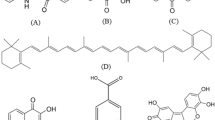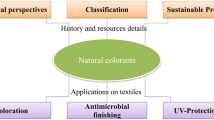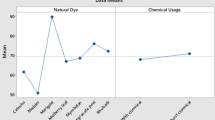Abstract
This study is anchored on the use of an eco-friendly effective plasma technique and cationization treatment to improve the hydrophobic nature of polyester (PET) fabric by incorporating hydrophilic functional groups onto the PET surface. The PET surface was initially treated with three different plasma gases prior to cationization treatment with quaternary ammonium salt (Quat 188). Madder roots were used, to produce natural dyes for the green coloration of PET fabrics in both dyeing and printing processes. The color strength (K/S) was measured to study the influence of both plasma gases and the cationization treatment on the coloration of PET fabric. Exposure to nitrogen plasma gases prior to the cationization treatment showed promising results for efficient PET coloration, resulting in the selection of nitrogen as a working gas at a flow rate of 3 l/min. The results also demonstrated that by combining the nitrogen plasma technique and cationization treatment, PET fabric with a highly effective surface was obtained, resulting in improved coloration, wettability, tensile strength, and roughness properties.














Similar content being viewed by others
References
Abdelghaffar F, Abdelghaffar RA, Arafa AA, Kamel MM (2018) Functional antibacterial finishing of woolen fabrics using ultrasound technology. Fibers Polym 19:2103–2111
Abdelghaffar F, Abdelghaffar RA, Mahmoud SA, Youssef BM (2019) Modified sugarcane bagasse for the removal of anionic dyes from aqueous solution. Pigm Resin Technol 48:464–471
Adeel S, Gulzar T, Azeem M, Saeed M, Hanif I, Iqbal N (2017) Appraisal of marigold flower based lutein as natural colourant for textile dyeing under the influence of gamma radiations. Radiat Phys Chem 130:35–39
Agnhage T, Perwuelz A, Behary N (2016) Eco-innovative coloration and surface modification of woven polyester fabric using bio-based materials and plasma technology. J Ind Crops Prod 86:334–341
Agnhage T, Zhou Y, Guan J, Chen G, Perwuelz A, Behary N, Nierstrasz V (2017) Bioactive and multifunctional textile using plant-based madder dye: characterization of UV protection ability and antibacterial activity. Fibers Polym 18:2170–2175
Ahmed H, Khattab TA, Mashaly H, El-Halwagy A, Rehan M (2020) Plasma activation toward multi-stimuli responsive cotton fabric via in situ development of polyaniline derivatives and silver nanoparticles. Cellulose: 27:2913–2926. https://doi.org/10.1007/s10570-020-02980-7
Barani H, Maleki H (2011) Plasma and ultrasonic process in dyeing of wool fibers with madder in presence of lecithin. J Dispers Sci Technol 32:1191–1199
Blackburn RS (2017) Natural dyes in madder (Rubia spp.) and their extraction and analysis in historical textiles. Color Technol 133:449–462
Costa T, Feitor M, Alves C Jr, Freire P, De Bezerra C (2006) Effects of gas composition during plasma modification of polyester fabrics. J Mater Process Technol 173:40–43
Elabid AE, Zhang J, Shi J, Guo Y, Ding K, Zhang J (2016) Improving the low temperature dyeability of polyethylene terephthalate fabric with dispersive dyes by atmospheric pressure plasma discharge. Appl Surf Sci 375:26–34
El-Zawahry MM, Abdelghaffar F (2013) Preparation and characterisation of novel phospholipid cationic liposomes to improve the alkaline hydrolysis and dyeability of polyester fabric. Color Technol 129:193–202
Francke K-P, Rudolph R, Miessner H (2003) Design and operating characteristics of a simple and reliable DBD reactor for use with atmospheric air. Plasma Chem Plasma Process 23:47–57
Gaminian H, Montazer M (2015) Enhanced self-cleaning properties on polyester fabric under visible light through single-step synthesis of cuprous oxide doped nano-TiO2. Photochem Photobiol 91:1078–1087
Garg S, Hurren C, Kaynak A (2007) Improvement of adhesion of conductive polypyrrole coating on wool and polyester fabrics using atmospheric plasma treatment. Synth Met 157:41–47
Gherardi N, Gouda G, Gat E, Ricard A, Massines F (2000) Transition from glow silent discharge to micro-discharges in nitrogen gas. Plasma Sources Sci Technol 9:340–346
Gorjanc M, Mozetič M, Primc G, Vesel A, Spasić K, Puač N, Petrović ZL, Kert M (2017) Plasma treated polyethylene terephthalate for increased embedment of UV-responsive microcapsules. Appl Surf Sci 419:224–234
Gotoh K, Yasukawa A (2011) Atmospheric pressure plasma modification of polyester fabric for improvement of textile-specific properties. Text Res J 81:368–378
Grčić I, Erjavec B, Vrsaljko D, Guyon C, Tatoulian M (2017) Influence of plasma surface pretreatment and triarylmethane dye on the photocatalytic performance of TiO2-chitosan coating on textile. Prog Org Coat 105:277–285
Gupta B, Edwards J (2009) 3-Textile materials and structures for wound care products. In: Advanced textiles for wound care. Elsevier, pp 48–96. https://doi.org/10.1533/9781845696306.1.48
Hakeim OA, Abdelghaffar F, Haroun AA (2019) UV-protection of cellulosic fabric prints using hyperbranched polyester-stabilized titania coating. Prog Org Coat 136:105295
Hardick O, Dods S, Stevens B, Bracewell DG (2013) Nanofiber adsorbents for high productivity downstream processing. Biotechnol Bioeng 110:1119–1128
Harifi T, Montazer M (2017) Application of sonochemical technique for sustainable surface modification of polyester fibers resulting in durable nano-sonofinishing. Ultrason Sonochem 37:158–168
He X, Zhou Q, Xie K (2014) Effect of PEGylated chitosan on plasma etched PET fabrics surface properties. J Appl Polym Sci:131:1–8
Hossain MM (2009) Plasma technology for deposition and surface modification. (Logos Verlag Berlin GmbH)
Kamel M, Abdelghaffar F, El-Zawahry M (2011) Eco-friendly dyeing of wool with a mixture of natural dyes. J Nat Fibers 8:289–307
Khattab TA, Haggag KM, Elnagdi MH, Abdelrahman AA, Abdelmoez AS (2016) Microwave-assisted synthesis of arylazoaminopyrazoles as disperse dyes for textile printing. Z Anorg Allg Chem 642:766–772
Khattab TA, Elnagdi MH, Haggaga KM, Abdelrahmana AA, Abdelmoez AS (2017) Green synthesis, printing performance, and antibacterial activity of disperse dyes incorporating arylazopyrazolopyrimidines. AATCC J Res 4:1–8
Khattab TA, Aly SA, Klapötke TM (2018a) Naked-eye facile colorimetric detection of alkylphenols using Fe (III)-impregnated silica-based strips. Chem Pap 72:1553–1559
Khattab TA, Fouda MM, Allam AA, Othman SI, Bin-Jumah M, Al-Harbi HM, Rehan M (2018b) Selective colorimetric detection of Fe (III) using metallochromic tannin-impregnated silica strips. ChemistrySelect 3:12065–12071
Khattab TA, Dacrory S, Abou-Yousef H, Kamel S (2019a) Development of microporous cellulose-based smart xerogel reversible sensor via freeze drying for naked-eye detection of ammonia gas. Carbohydr Polym 210:196–203
Khattab TA, Dacrory S, Abou-Yousef H, Kamel S (2019b) Smart microfibrillated cellulose as swab sponge-like aerogel for real-time colorimetric naked-eye sweat monitoring. Talanta 205:120166
Khattab TA, Fouda MM, Abdelrahman MS, Othman SI, Bin-Jumah M, Alqaraawi MA, Al Fassam H, Allam AA (2019c) Co-encapsulation of enzyme and tricyanofuran hydrazone into alginate microcapsules incorporated onto cotton fabric as a biosensor for colorimetric recognition of urea. React Funct Polym 142:199–206
Leroux F, Campagne C, Perwuelz A, Gengembre L (2008) Fluorocarbon nano-coating of polyester fabrics by atmospheric air plasma with aerosol. Appl Surf Sci 254:3902–3908
Lv J, Zhou Q, Zhi T, Gao D, Wang C (2016) Environmentally friendly surface modification of polyethylene terephthalate (PET) fabric by low-temperature oxygen plasma and carboxymethyl chitosan. J Clean Prod 118:187–196
Mech J, Grela MA, Szaciłowski K (2014) Ground and excited state properties of alizarin and its isomers. Dyes Pigments 103:202–213
Nersisyan G, Graham W, Technology (2004) Characterization of a dielectric barrier discharge operating in an open reactor with flowing helium. Plasma Sources Sci Technol 13:582–587
Parvinzadeh M, Ebrahimi I (2011) Influence of atmospheric-air plasma on the coating of a nonionic lubricating agent on polyester fiber. Radiat Eff Defects Solids 166:408–416
Roy S, Yue CY (2011) Surface modification of COC microfluidic devices: a comparative study of nitrogen plasma treatment and its advantages over argon and oxygen plasma treatments. Plasma Process Polym 8:432–443
Sadeghi-Kiakhani M (2015) Eco-friendly dyeing of wool and nylon using madder as a natural dye: kinetic and adsorption isotherm studies. Int J Environ Sci Technol 12:2363–2370
Shahid M, Mohammad F (2013) Recent advancements in natural dye applications: a review. J Clean Prod 53:310–331
Vogel AI (1975) Elementary practical organic chemistry, part 3, quantitative organic analysis. Longman Group Ltd, London
Wilson D, Rhodes N, Williams R (2003) Surface modification of a segmented polyetherurethane using a low-powered gas plasma and its influence on the activation of the coagulation system. Biomaterials 24:5069–5081
Zaman M, Liu H, Xiao H, Chibante F, Ni Y (2013) Hydrophilic modification of polyester fabric by applying nanocrystalline cellulose containing surface finish. Carbohydr Polym 91:560–567
Zhang C, Zhao M, Wang L, Qu L, Men Y (2017) Surface modification of polyester fabrics by atmospheric-pressure air/He plasma for color strength and adhesion enhancement. Appl Surf Sci 400:304–311
Zille A, Oliveira FR, Souto AP (2015) Plasma treatment in textile industry. Plasma Process Polym 12:98–131
Author information
Authors and Affiliations
Corresponding author
Additional information
Responsible editor: Angeles Blanco
Publisher’s note
Springer Nature remains neutral with regard to jurisdictional claims in published maps and institutional affiliations.
Rights and permissions
About this article
Cite this article
Abdelghaffar, F., Abdelghaffar, R.A., Rashed, U.M. et al. Highly effective surface modification using plasma technologies toward green coloration of polyester fabrics. Environ Sci Pollut Res 27, 28949–28961 (2020). https://doi.org/10.1007/s11356-020-09081-9
Received:
Accepted:
Published:
Issue Date:
DOI: https://doi.org/10.1007/s11356-020-09081-9




